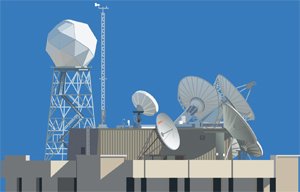Library News
by Jean Phillips
SSEC Satellite Meteorology Timeline
Because we're so convinced that describing and chronicling SSEC's role in satellite meteorology, is a worthy pursuit for supporting future science, we've developed the SSEC Satellite Meterology Timeline to showcase it. The library team is pleased to announce this addition to its collection of digital resources.
The world’s fascination with space exploration followed quickly on the heels of the 1957 International Geophysical Year (IGY) and the Soviet Union’s successful launch of Sputnik later that same year. NASA, founded in 1958, paved the way for ‘peaceful and scientific’ exploration of space in the United States – not only funding scientific research programs, but providing funding to establish research centers like SSEC.
Thematically, the evolution of satellite meteorology at SSEC is characterized by eras of specific scientific needs and objectives realized by specific scientific programs and technologies. Consider it a work in progress -- we'd like your comments and suggestions to enhance this timeline that reflects the Center's rich history and promising future.
Many thanks to the library team for research, content development, design, layout, and programming work over the last year and a half to make this resource a reality: Keely Merchant, Linda Hedges, Brian Anderson.
Severe Weather Awareness in Wisconsin: New Library Exhibit
Disaster occurrences, including those resulting from tornadoes, heat, flooding and wind events result in staggering economic losses, deaths and injuries. With increasing urban populations across the globe, more people are vulnerable to these types of events each year. According to the World Meteorological Organization (WMO), natural disasters affected an average of 200 million people and claimed 62,000 lives annually during the 1990s. And in the period 2000-2011, the International Strategy for Disaster Reduction, reports 1.1 million people were killed.
Though often known for its cold weather, Wisconsin is no stranger to tornadoes, wind and other severe weather events, including extreme heat.
Early warning systems are critical. The science research community continues a pivotal role in providing specialized expertise to assist governments and communities in developing early warning systems. Countries with strong national warning systems generally have strong public information campaigns. In Wisconsin, and across the United States, people are more likely to pay attention to warnings when they have reliable information about their risks.
Check out the new exhibit in the corridor just outside the Library.
New Library Catalog Replaces MadCat
The UW Libraries officially launched the new Library Catalog on May 21st supplementing the nearly 15-year-old MadCat. It features a friendlier interface that makes it easier to find books, journals and other resources needed for student and faculty research.
Key features:- Intuitive interface for fast discovery
- Facets, limits and narrowing for all searches
- Seamless portal to all UW System libraries
- Easy access to your account information
- Mobile friendly
After May 21, MadCat will still be available, but most links from the Library Website will point to the new Library Catalog.
New Electronic Books
To locate these books, search for their titles in the Library Catalog. Most of them are available in electronic format:
- Coiffier, Jean. Fundamentals of numerical weather prediction. Cambridge, 2011.
- Doombos, Eelco. Thermospheric density and wind determination from satellite dynamics. Springer,2012.
- Duchon,. Claude and Hale, Robert. Time series analysis in meteorology and climatology : an introduction. Wiley, 2012.
- Eddy covariance : a practical guide to measurement and data analysis. Aubinet, Marc, et al, eds. Springer, 2012.
- Emeis, Stefan. Surface-based remote sensing of the atmospheric boundary layer. Springer, 2011.
- Earth observing systems XVI : 23-25 August 2011, San Diego, California, United States. SPIE, 2011.
- Hapke, Bruce. Theory of reflectance and emittance spectroscopy. Cambridge, 2012.
- Jolliffe, Ian T. and Stephenson, David B. Forecast verification : a practitioner’s guide in atmospheric science. Wiley, 2012.
- Lemke, Peter and Jacobi, Hans-Werner, eds. Arctic climate change: the ACSYS decade and beyond. Springer, 2012.
- Li, Xiaofan and Gao, Shouting. Precipitation modeling and quantitative analysis. Springer, 2012.
- Martin, Seelye. Introduction to ocean remote sensing. Cambridge, 2011.
- Molders, Nicole. Land-use and land-cover changes : impact on climate and air quality. Springer, 2012.
- Neelin, J. David. Climate change and climate modeling. Cambridge, 2011.
- Remote sensing of clouds and the atmosphere XVI : 21-22 September 2011, Prague, Czech Republic. SPIE, 2011.
- Rosenzweig, Cynthia. Climate change and cities : First Assessment Report of the Urban Climate Change Research Network. Cambridge, 2011.
- Suzuki-Parker, Asuka. Uncertainties and limitations in simulating tropical cyclones. Springer, 2012.
- Turner, John and Marxhall, Gareth J. Climate change in the polar regions. Cambridge, 2011.
- Vallis, Geoffrey K. Climate and the oceans. Princeton, 2011.
- Warneck, P. and Williams, J. The atmospheric chemist’s companion.: numerical data for use in the atmospheric sciences. Springer, 2012.
- Wells, Neil C. The atmosphere and ocean : a physical introduction. Wiley, 2012.
 |
|

